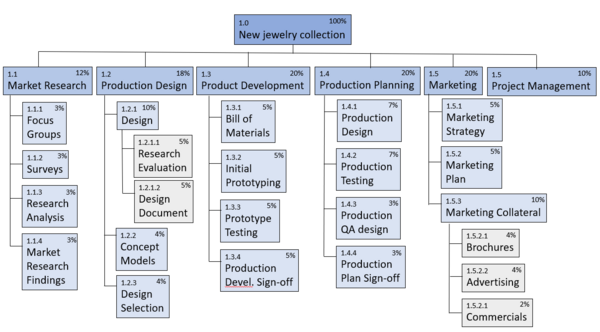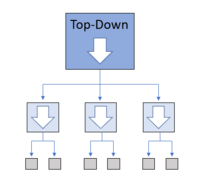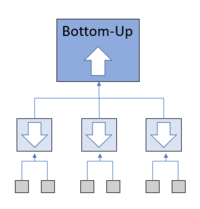WBS, Work Breakdown Structure
(→Work Breakdown Structure) |
(→WBS elements) |
||
| Line 14: | Line 14: | ||
== WBS elements == | == WBS elements == | ||
| − | There are some key components which a typical Work Breakdown Structure | + | There are some key components which a typical Work Breakdown Structure consists of. These components are listed below and are accompanied by a brief introduction to some of the terms subsequently used in this article. |
'''WBS Dictionary''' | '''WBS Dictionary''' | ||
| − | To navigate in a complex project, it is important to have a WBS dictionary that defines the elements in the project work. This is a supplement to the visual tool the WBS provides and gives more detailed information about the activities. Often the substantial chunks in the Work Breakdown Structure have a title and a number that refers to the WBS Dictionary. | + | To navigate in a complex project, it is important to have a WBS dictionary that defines the elements in the project work. This is a supplement to the visual tool the WBS provides and gives more detailed information about the activities in order to keep the WBS simple and with information held at a minimum. This helps accomplish the hurdle of “simple but not simplistic”. Often the substantial chunks in the Work Breakdown Structure have a title and a number that refers to the WBS Dictionary. |
'''WBS Levels''' | '''WBS Levels''' | ||
| − | The levels are an essential factor to create the hierarchical structure that makes the WBS efficient. It is important not to have | + | The levels are an essential factor to create the hierarchical structure that makes the WBS efficient. It is important not to have too many levels in the WBS because it can cause a messy and complicated structure, which is the opposite of the main purpose of the tool - which is to make a simple and visual structure of a complex project. The most common Work Breakdown Structures have three levels, which consist of (i) the project’s main deliverables, (ii) the project’s deliverables and (iii) the work packages. |
'''Project Deliverables''' | '''Project Deliverables''' | ||
| − | + | Project deliverables are not the final outputs of the project but the outcome of the work packages. It refers to the all the outputs that are submitted within the scope of the project. The project deliverables are those defined in level 2 of the WBS. | |
| − | + | ||
| − | + | ||
| − | Project deliverables are not the final outputs of the project but the outcome of the work packages. It refers to the all the outputs that are submitted within the scope of the project. | + | |
| + | '''Work Packages''' | ||
| + | The work packages are the lowest level of the WBS. It is a group of tasks that seems like a project themselves and can therefore be assigned to a team member. These work packages help to get the tasks executed and contributes to the overarching goal of the final project. The work packages can vary in the level of detail due to the complexity and size of the project. However, the work packages must follow the “8 to 80” rule which indicates that the work should take more than 8 hours but less than 80 hours. The work packages also contribute to an estimation of costs and durations of the project. | ||
[[File:simpleWBS.jpeg|400px|thumb|right|Illustration of the Bottom-Up approach. Made with inspiration from <ref name=>https://gabriel-rabhi-dev.com/2019/02/14/les-richesses-cachees-des-notions-top-down-et-bottom-up-partie-1-fr/</ref>]] | [[File:simpleWBS.jpeg|400px|thumb|right|Illustration of the Bottom-Up approach. Made with inspiration from <ref name=>https://gabriel-rabhi-dev.com/2019/02/14/les-richesses-cachees-des-notions-top-down-et-bottom-up-partie-1-fr/</ref>]] | ||
| Line 39: | Line 38: | ||
[[File:bottomup.png|200px|thumb|right|Illustration of the Bottom-Up approach. Made with inspiration from <ref name=>https://gabriel-rabhi-dev.com/2019/02/14/les-richesses-cachees-des-notions-top-down-et-bottom-up-partie-1-fr/</ref>]] | [[File:bottomup.png|200px|thumb|right|Illustration of the Bottom-Up approach. Made with inspiration from <ref name=>https://gabriel-rabhi-dev.com/2019/02/14/les-richesses-cachees-des-notions-top-down-et-bottom-up-partie-1-fr/</ref>]] | ||
| − | |||
| − | |||
| − | |||
== Bibliography == | == Bibliography == | ||
<references/> | <references/> | ||
Revision as of 06:11, 20 March 2022
Contents |
Abstract
This article examines the WBS, an acronym for Work Breakdown Structure. As a project manager it is important to possess certain competencies and qualities to achieve a successful project. However, personal skills such as communication, conflict management and being motivational are not sufficient on its own to make a project successful. As a project manager it is crucial to be aware and recognize the usefulness of various tools and concepts to help consider all aspects of a project, ranging from purpose, risks and planning. The Work Breakdown Structure is a common tool used in project management to establish an overview of the project at hand and to divide tasks into smaller and more manageable sections. This is a powerful concept when planning complex projects because it visualizes the scope of the project in a hierarchical way, and furthermore because it helps identify key process groups, such as Project Planning, Scheduling, Risk- and Resource Management, Team Management, etc. This article aims at providing an overall understanding of the WBS, including its purpose, different types, various levels and specific elements. Constructing a detailed WBS is essential to create the best project overview, however, it is equally crucial to go just deep enough, so that the WBS does not get confusing. Hence, a WBS must be simple but not simplistic. If not simple the WBS loses its relevance and usefulness to the project manager. If simplistic, then the project manager risks missing something crucial. Examples of a Work Breakdown Structure and illustrations are included to emphasize the theory and solidify its purpose. Finally, the advantages and disadvantages of the Work Breakdown Structure are presented to clarify the strengths and weaknesses of using this tool.
Introduction
“The art of simplicity is a puzzle of complexity” (Douglas Horton). A puzzle consists of many small pieces that together create art. Likewise, a project also consists of many small tasks executed by many different people. Separating the project into smaller pieces of doable tasks makes it possible to delegate. Coordinating these smaller tasks, so that they together contribute to the purpose of the project, as the small puzzle pieces fit together, makes every piece integrated.
Work Breakdown Structure
Work Breakdown Structure is efficient tool used in Project Management to simply break the work down into a structure. A WBS is a product-oriented family tree that identifies the deliverables required to achieve the project end. The Work Breakdown Structure is a hierarchical and visualized way to divide the work into several substantial chunks, which further breaks down into new more detailed chunks. This decomposition creates an overview of the needed tasks to accomplish the project and makes it more manageable. A Work Breakdown Structure is an efficient tool used in Project Management to simply break the work down into various subsections that create a structured approach to the project. A WBS is a product-oriented family tree that identifies the deliverables required to achieve the project end. In the PMBOK the Work Breakdown Structure is defined as “A deliverable-oriented hierarchical decomposition of the work to be executed by the project team to accomplish the project objectives and create the required deliverables. It organizes and defines the total scope of the project. Each descending level represents an increasingly detailed definition of the project work.” The Work Breakdown Structure is a hierarchical and visualized approach to divide the work into several substantial chunks, which further breaks down into new more detailed chunks. This decomposition creates an overview of the tasks needed to accomplish the project and makes it more manageable. The WBS is a powerful tool to use in the planning phase to help kickstart the project and to visualize how the project can evolve. It further enables increased tracking in later stages of the project as specific tasks are completed.
WBS elements
There are some key components which a typical Work Breakdown Structure consists of. These components are listed below and are accompanied by a brief introduction to some of the terms subsequently used in this article.
WBS Dictionary To navigate in a complex project, it is important to have a WBS dictionary that defines the elements in the project work. This is a supplement to the visual tool the WBS provides and gives more detailed information about the activities in order to keep the WBS simple and with information held at a minimum. This helps accomplish the hurdle of “simple but not simplistic”. Often the substantial chunks in the Work Breakdown Structure have a title and a number that refers to the WBS Dictionary.
WBS Levels The levels are an essential factor to create the hierarchical structure that makes the WBS efficient. It is important not to have too many levels in the WBS because it can cause a messy and complicated structure, which is the opposite of the main purpose of the tool - which is to make a simple and visual structure of a complex project. The most common Work Breakdown Structures have three levels, which consist of (i) the project’s main deliverables, (ii) the project’s deliverables and (iii) the work packages.
Project Deliverables Project deliverables are not the final outputs of the project but the outcome of the work packages. It refers to the all the outputs that are submitted within the scope of the project. The project deliverables are those defined in level 2 of the WBS.
Work Packages The work packages are the lowest level of the WBS. It is a group of tasks that seems like a project themselves and can therefore be assigned to a team member. These work packages help to get the tasks executed and contributes to the overarching goal of the final project. The work packages can vary in the level of detail due to the complexity and size of the project. However, the work packages must follow the “8 to 80” rule which indicates that the work should take more than 8 hours but less than 80 hours. The work packages also contribute to an estimation of costs and durations of the project.




Bibliography
- ↑ https://gabriel-rabhi-dev.com/2019/02/14/les-richesses-cachees-des-notions-top-down-et-bottom-up-partie-1-fr/
- ↑ https://projectinsight.com/project-management-basics/project-management-schedule
- ↑ https://gabriel-rabhi-dev.com/2019/02/14/les-richesses-cachees-des-notions-top-down-et-bottom-up-partie-1-fr/
- ↑ https://gabriel-rabhi-dev.com/2019/02/14/les-richesses-cachees-des-notions-top-down-et-bottom-up-partie-1-fr/